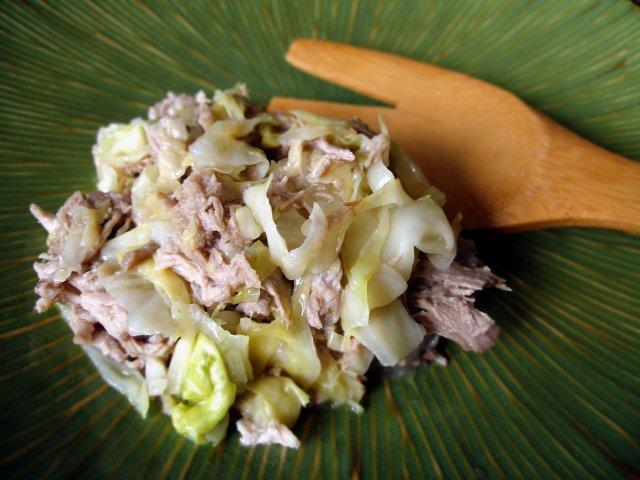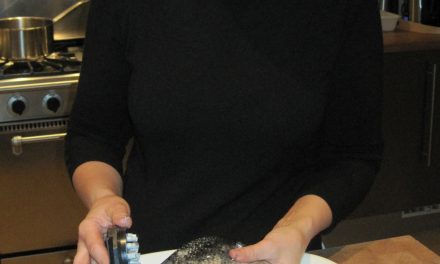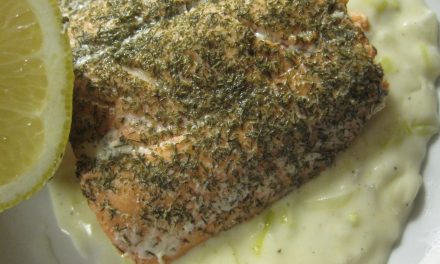This is by far one of my favorite recipes. I first tried it in Hawaii years ago and it is one of my favorite comfort foods. Traditionally the pork, actually a whole cleaned and dressed pig, is placed in an imu overnight. So you say, “What is an imu?” An imu is an underground oven that is lined with a type of river rock that is slightly porous to prevent the stone from cracking. Then Kiawe, the Hawaiian equivalent of mesquite, is placed on the stones and set afire. When the flames stop, the coals are ready. Next, banana stumps and leaves are placed into the imu to steam and impart moisture . Usually a whole pig wrapped in chicken wire (to hold the roast together when removing it) is placed on the banana stumps. If you’re going on a smaller scale a large sturdy foil pan will be fine. Next banana stumps and leaves are very generously placed around and on top of the roast. Ti leaves are also used to line the roast. The purpose is to seal in the moisture with the leaves and to steam the roast.
Finally, damp burlap sacks are piled on the leaves followed by sand to button the entire oven up. After 12 hours all the coverings are removed and the feast begins. The result is a butter-tender roast that is ono (delicious). If you lack an imu or the ability to create one on the trail, I have adapted this recipe for home to finish at camp – it’s still lip-smacking good!
Here’s what you’ll need:
Pressure cooker
Pork butt or shoulder. The weight depends on how many people you want to feed; a good starting point is about 5 lbs.
1 large green cabbage
3 large sweet onions
2 caps-full liquid smoke (use the bottle’s plastic cap)
Extra virgin Olive oil
Hawaiian rock salt; sea salt or coarse Kosher salt will work in a pinch
1 tablespoon soy sauce, I recommend Yamasa brand made in Eugene, Oregon
Freshly cracked pepper to taste
White rice (Calrose is a good brand) quantity varies with the number friends you’re treating with this. Do not use Uncle Ben’s.
If you don’t have a pressure cooker, go get one. They are very easy to use, save a lot of time and are energy efficient. But most importantly, you can take a very tough, inexpensive cut of any meat and the pressure will tenderize the cut to fork tender in an hour or so. Just follow the directions that came with the cooker.
To prepare the dish, begin by placing the meat into the cooker with about a cup of water or beef or chicken stock. Seal the lid and bring it up to the correct heat. In about an hour the meat should be done. Let the cooker cool before opening. When cooled, remove the meat and shred with a fork, removing any excess fat. Take the stock from the pot and skim that fat off, too. For camping the shredded meat can be frozen for later use at your camp site.
If you want to enjoy at home, here’s how to continue. Slice the cabbage and onions into one quarter-inch slices. Add olive oil to a large pot and saute the vegetables for about ten minutes. Reduce the heat to low and add the shredded pork, the skimmed stock, soy sauce, liquid smoke to taste, and finally, the rock salt. Be careful here, you don’t want to over-salt the food with the soy and salt. The liquid smoke is really done by taste, it’s very strong so be careful with it.
Next make the rice, traditionally served with this dish. If you have a rice cooker you know what to do. If you don’t, you can make the rice at home on the stove or over the campfire. Rice goes pretty far so I figure about one half cup uncooked rice for four people. If you’re not sure, just make more, it’s very cheap to do. To cook the rice the key is the correct amount of water. So, as a rule of thumb you can measure it like this: a basic rule is two parts water to one part rice, just rinse the rice in cool water to remove any dust and/or starch. Cook the rice over medium heat until the water begins to boil, then turn the heat down to low and cook slowly until tender, about 20 minutes. Finally, if you want to go a bit lower fat, I have done this recipe with a turkey breast found in the frozen section of your local market, and it is just as good as the pork.
Editor’s note: If using brown rice instead of white, allow about 40 minutes to cook.






